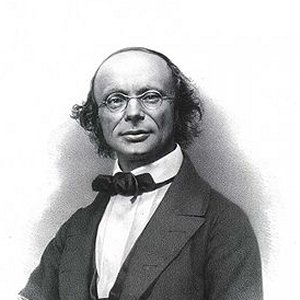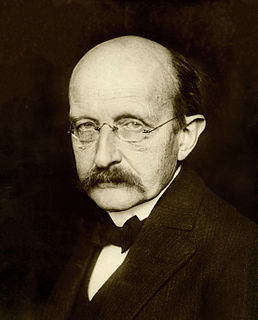
The multiverse is a hypothetical group of multiple universes including the universe in which we live. Together, these universes comprise everything that exists: the entirety of space, time, matter, energy, and the physical laws and constants that describe them. The different universes within the multiverse are called "parallel universes", "other universes", or "alternate universes".

Physics is the natural science that studies matter and its motion and behavior through space and time and that studies the related entities of energy and force. Physics is one of the most fundamental scientific disciplines, and its main goal is to understand how the universe behaves.

Max Born was a German-Jewish physicist and mathematician who was instrumental in the development of quantum mechanics. He also made contributions to solid-state physics and optics and supervised the work of a number of notable physicists in the 1920s and 1930s. Born won the 1954 Nobel Prize in Physics for his "fundamental research in quantum mechanics, especially in the statistical interpretation of the wave function".

The Cavendish Laboratory is the Department of Physics at the University of Cambridge, and is part of the School of Physical Sciences. The laboratory was opened in 1874 on the New Museums Site as a laboratory for experimental physics. The laboratory moved to its present site in West Cambridge in 1974. As of 2011, 29 Cavendish researchers have won Nobel Prizes. In the Research Excellence Framework the Cavendish Laboratory is ranked as the 7th-equal best physics department in the country.
Physics and Beyond is a book by Werner Heisenberg, the German physicist who discovered the uncertainty principle. It tells, from his point of view, the history of exploring atomic science and quantum mechanics in the first half of the 20th century.

Wilhelm Eduard Weber was a German physicist and, together with Carl Friedrich Gauss, inventor of the first electromagnetic telegraph.

Max Theodor Felix von Laue was a German physicist who won the Nobel Prize in Physics in 1914 for his discovery of the diffraction of X-rays by crystals. In addition to his scientific endeavors with contributions in optics, crystallography, quantum theory, superconductivity, and the theory of relativity, he had a number of administrative positions which advanced and guided German scientific research and development during four decades. A strong objector to National Socialism, he was instrumental in re-establishing and organizing German science after World War II.

The Max Planck Society for the Advancement of Science is a formally independent non-governmental and non-profit association of German research institutes founded in 1911 as the Kaiser Wilhelm Society and renamed the Max Planck Society in 1948 in honor of its former president, theoretical physicist Max Planck. The society is funded by the federal and state governments of Germany.
The Max Planck Institute for Astrophysics (MPA) is a research institute located in Garching, just north of Munich, Bavaria, Germany. It is one of many scientific research institutes belonging to the Max Planck Society.

Yuri Ivanovitch Manin is a Russian mathematician, known for work in algebraic geometry and diophantine geometry, and many expository works ranging from mathematical logic to theoretical physics. Moreover, Manin was one of the first to propose the idea of a quantum computer in 1980 with his book "Computable and Uncomputable".
Gary L. Drescher is a scientist in the field of artificial intelligence (AI), author of the book Made-Up Minds: A Constructivist Approach to Artificial Intelligence.
In physics and cosmology, the mathematical universe hypothesis (MUH), also known as the ultimate ensemble theory, is a speculative "theory of everything" (TOE) proposed by cosmologist Max Tegmark.

Huang Kun was a Chinese physicist and an academician of the Chinese Academy of Sciences. He was awarded the State Preeminent Science and Technology Award by President Jiang Zemin in 2001.
Quantum mysticism is a set of metaphysical beliefs and associated practices that seek to relate consciousness, intelligence, spirituality, or mystical worldviews to the ideas of quantum mechanics and its interpretations. Quantum mysticism is considered by most scientists and philosophers to be pseudoscience or quackery.

Peter Zoller is a theoretical physicist from Austria. He is Professor at the University of Innsbruck and works on quantum optics and quantum information and is best known for his pioneering research on quantum computing and quantum communication and for bridging quantum optics and solid state physics.

The Max Planck Institute for Medical Research in Heidelberg, Germany, is a facility of the Max Planck Society for basic medical research. Since its foundation, six Nobel Prize laureates worked at the Institute: Otto Fritz Meyerhof (Physiology), Richard Kuhn (Chemistry), Walther Bothe (Physics), André Michel Lwoff, Rudolf Mößbauer (Physics), Bert Sakmann and Stefan W. Hell (Chemistry).
Einstein and Religion: Physics and Theology (1999) is a book on the religious views of Nobel prize-winning physicist Albert Einstein by Max Jammer, published by Princeton University Press.
In physics, a quantum is the minimum amount of any physical entity involved in an interaction. The fundamental notion that a physical property may be "quantized" is referred to as "the hypothesis of quantization". This means that the magnitude of the physical property can take on only discrete values consisting of integer multiples of one quantum.

The University of Edinburgh School of Physics and Astronomy is the physics department of the University of Edinburgh. The school was formed in 1993 by a merger of the Department of Physics - called the Department of Natural Philosophy until the late 1960s - and the Department of Astronomy, both at the University of Edinburgh. The school is part of the University's College of Science and Engineering.
















